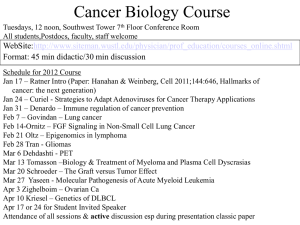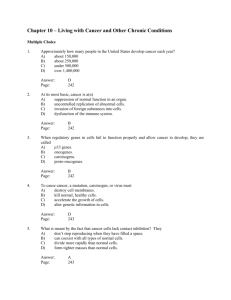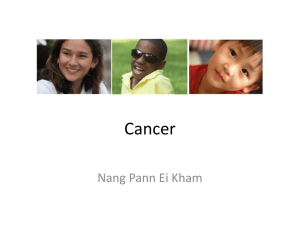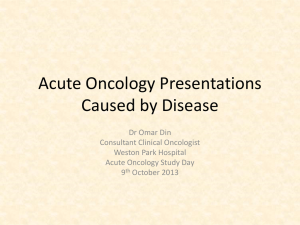Chap11, Ch11
advertisement
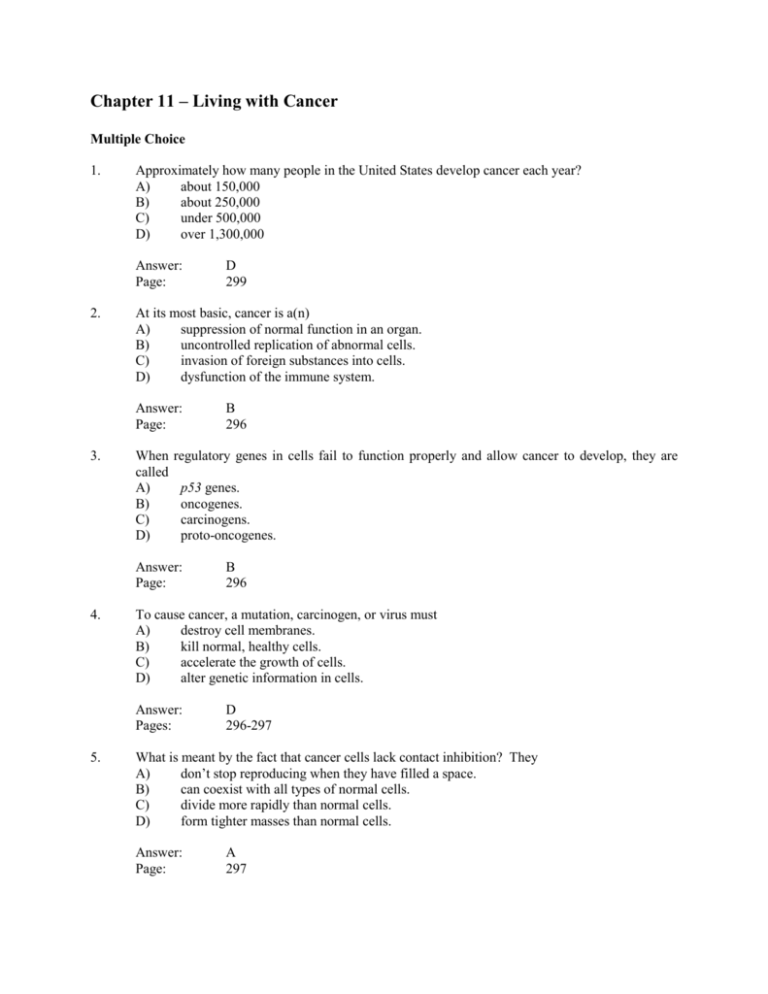
Chapter 11 – Living with Cancer Multiple Choice 1. Approximately how many people in the United States develop cancer each year? A) about 150,000 B) about 250,000 C) under 500,000 D) over 1,300,000 Answer: Page: 2. At its most basic, cancer is a(n) A) suppression of normal function in an organ. B) uncontrolled replication of abnormal cells. C) invasion of foreign substances into cells. D) dysfunction of the immune system. Answer: Page: 3. When called A) B) C) D) p53 genes. oncogenes. carcinogens. proto-oncogenes. B 296 To cause cancer, a mutation, carcinogen, or virus must A) destroy cell membranes. B) kill normal, healthy cells. C) accelerate the growth of cells. D) alter genetic information in cells. Answer: Pages: 5. B 296 regulatory genes in cells fail to function properly and allow cancer to develop, they are Answer: Page: 4. D 299 D 296-297 What is meant by the fact that cancer cells lack contact inhibition? They A) don’t stop reproducing when they have filled a space. B) can coexist with all types of normal cells. C) divide more rapidly than normal cells. D) form tighter masses than normal cells. Answer: Page: A 297 6. Metastasis is the term used to describe the cancer cell’s ability to A) spread to other sites in the body. B) protect itself from toxic substances. C) escape detection by the immune system. D) command extra blood supply from the circulatory system. Answer: Page: 7. One of the dangerous properties of cancer cells is that they A) ingest normal cells. B) can live indefinitely. C) grow larger than normal cells. D) can kill other cells on contact. Answer: Page: 8. B 298 In the United States, the most commonly occurring malignant cancers are A) carcinomas. B) melanomas. C) leukemias. D) sarcomas. Answer: Page: 11. C 298 When doctors use terms such as carcinoma, sarcoma, and melanoma to describe cancers, they are naming them according to the A) speed at which they spread. B) basis of their cell type. C) TNM staging system. D) rate at which they are cured. Answer: Page: 10. B 297 A tumor that does not spread to other sites in the body is labeled A) proto-oncogenic. B) inoperable. C) benign. D) local. Answer: Page: 9. A 297 A 298 You can reduce your risk of developing melanoma by A) avoiding cigarettes. B) abstaining from alcohol use. C) avoiding exposure to carcinogenic chemicals. D) protecting yourself from excessive exposure to the sun. Answer: Page: 12. Hepatoma is cancer of the A) endocrine system. B) immune system. C) connective tissue. D) liver. Answer: Page: 13. C 304 What percentage of lung cancer victims are smokers? A) about 50 percent B) 65-75 percent C) 85-90 percent D) over 95 percent Answer: Page: 16. B 299 Which of the following is TRUE of people who have a hereditary risk of developing lung cancer? A) They are genetically destined to have lung cancer. B) They will have lung cancer if they become smokers. C) If they do not smoke, they lower their lung cancer risk significantly. D) Smoking is less significant as a lung cancer risk factor for them. Answer: Page: 15. D 298 Which of the following is the MOST lethal form of cancer for women? A) breast B) lung C) ovarian D) cervical Answer: Page: 14. D 298 C 304 A Gail score of 1.66 percent indicates A) low risk for breast cancer. B) high risk for breast cancer C) that a prophylactic mastectomy is required. D) that the cancer is inoperable. Answer: Page: B 309 17. Which of the following is NOT a risk factor for developing breast cancer? A) women whose menstrual period began at a later age B) women who have had no children C) women whose diet is high in fat D) women who have used hormone replacement therapy Answer: Page: 18. Cheyenne learns from genetic screening that she has a mutated version of the BRCA1 gene. She also has a family history of breast cancer. The LEAST helpful recommendation for her is A) a prophylactic mastectomy. B) frequent, thorough examinations for breast cancer. C) preventive drug therapy, if judged appropriate by her doctor. D) breast self-examination and annual mammograms beginning at age 50. Answer: Pages: 19. A 309-310 Which type of skin cancer presents as a painless bump and is often mistaken for a cyst? A) melanoma B) basal cell C) Merkel cell carcinoma D) squamous cell Answer: Page: 22. A 308 The most effective tool for identifying breast cancer is A) mammography B) a family history C) self-examination D) genetic screening Answer: Pages: 21. D 308-309 A prophylactic mastectomy is A) removal of healthy breast tissue to avoid the risk of breast cancer. B) a mastectomy that includes the immediate insertion of a breast implant. C) removal of all breast tissue and nearby lymph nodes to treat breast cancer. D) removal of the cancerous lump itself and a small amount of surrounding tissue. Answer: Page: 20. A 309 C 303 Nina’s doctor suggested that, instead of her annual X-ray mammogram, she will have an MRI exam. How should Nina respond? She A) should toss a coin; both are equally good. B) can be confident that her doctor is recommending a valuable, up-to-date procedure. C) should inquire further to make sure that this is not a managed care attempt at cost cutting. D) should inquire further, because MRI is more expensive and adds little diagnostic value. Answer: Pages: 23. The most effective and currently available screening method for cervical cancer is A) X-ray. B) the Pap test. C) HPV screening. D) a vaginal blood test. Answer: Page: 24. C 313-314 Sheryl has many sexual partners but wants to avoid cervical cancer. Besides regular Pap tests, she could BEST lower her risk by which of the following? A) taking up smoking B) abstaining from alcohol C) taking a prescription antibiotic D) using condoms Answer: Page: 27. D 309 The Pap test is the A) use of a dye to enable X-ray identification of precancerous cells. B) endoscopic examination of the uterine lining for abnormalities. C) removal of a sample of cervical cells for examination. D) screening blood samples for cancer cell markers. Answer: Pages: 26. B 313 Which drug therapy is highly effective for women whose type of breast cancer was stimulated by the presence of estrogen? A) herceptin B) hormone replacement therapy C) cisplatin D) tamoxifen Answer: Page: 25. B 301, 311 D 314 Blood clots, endometrial cancer, stroke, and cataracts are all possible side effects of which class of drugs that is used to treat breast cancer? A) aromatase inhibitors B) estrogen receptor modulators C) beta blockers D) GVAX Answer: B Page: 28. Uterine cancer is cancer of the A) cervix. B) ovaries. C) vaginal canal. D) wall of the uterus. Answer: Page: 29. C 316 Women in whom ovarian cancer has been diagnosed often report that the only symptoms were A) sharp abdominal pains that are strongest during activity. B) the disappearance of the sex drive. C) nausea and vomiting. D) digestive disturbances. Answer: Page: 33. A 316 Thirty-five-year-old Tara is considering having her ovaries surgically removed to avoid the risk of ovarian cancer. In which of the following cases would this make the most sense? A) She is unmarried. B) She has had more than six children. C) Her family has a strong history of ovarian cancer. D) She was exposed to the drug DES before birth. Answer: Page: 32. A 309 Vaginal cancer is most likely to occur among A) daughters of mothers who took the drug DES during pregnancy. B) women who abuse barbiturates and tranquilizers. C) daughters of breast cancer patients. D) women who are sexually active. Answer: Page: 31. D 309 The principal risk factor related to the development of uterine cancer is A) high estrogen levels. B) early menopause. C) multiple sexual partners. D) late onset of menstruation. Answer: Page: 30. 309 D 316 Which of the following is the second leading cause of cancer deaths among American men? A) lung cancer B) prostate cancer C) D) testicular cancer colorectal cancer Answer: Page: 34. The greatest risk factor for prostate cancer among men is A) age. B) obesity. C) dietary fat intake. D) sexual promiscuity. Answer: Page: 35. B 312 Which of the following types of solid tumors are most common among young men? A) breast B) prostate C) testicular D) colorectal Answer: Page: 38. A 312 One of the most common symptoms of prostate cancer is A) abdominal pain. B) difficulty in urinating. C) nausea and vomiting. D) loss of sexual function. Answer: Page: 37. A 312 Which of the following has been shown to play a preventative role in prostate cancer? A) an increase in the dietary intake of vitamin E and selenium B) an increase in the dietary intake of citrus juices C) an increase in sexual activity D) an increase in aerobic exercise Answer: Page: 36. B 311 C 313 The most important early detection measure for testicular cancer in men is A) a urinalysis. B) a yearly X-ray. C) self-examination. D) a yearly blood test. Answer: Page: C 313 39. Treatment for testicular cancer most commonly includes A) removal of both testicles and the prostate gland. B) removal of the affected testicle. C) chemotherapy. D) radiation. Answer: Page: 40. Fred detects a small lump on one of his testicles and naturally wonders if he has cancer. He should be most suspicious if it A) is painless. B) is painful to the touch. C) disappears the following day. D) becomes larger and softer the following day. Answer: Page: 41. B 306 The use of food, food products, or medications to bolster the immune system or reduce the damage caused by carcinogens is termed A) chemoprevention. B) chemonutrition. C) chemointervention. D) chemotherapy. Answer: Page: 44. A 306 Small precancerous pouchings in the wall of the lower intestinal tract are called A) nodes. B) polyps. C) lesions. D) cystolas. Answer: Page: 43. A 313 The second leading cause of cancer deaths in males is ___________ cancer. A) colon B) kidney C) lymphatic D) skin Answer: Page: 42. B 313 A 320 Thirty-five-year-old Ken experienced a change in bowel habits, and a stool test revealed abnormal amounts of blood. The most likely next step for Ken is A) chemotherapy. B) C) D) a colonoscopy. radiation treatments. surgical removal of the colon. Answer: Page: 45. Pancreatic cancer is more common in A) African American men. B) Hispanic women. C) Asian women. D) Caucasian men. Answer: Page: 46. A 317 One of the main difficulties in detecting lymphatic cancer is that A) it is hard to diagnose. B) there are no noticeable symptoms. C) people are afraid to report it to their doctors. D) the symptoms are similar to those of less serious illnesses. Answer: Page: 49. D 317 Your 56-year-old brother has been diagnosed with pancreatic cancer. Which of the following scenarios is most likely? A) He has only a 5 percent survival rate five years after diagnosis. B) The disease will go into spontaneous remission. C) He will die of another cause before this becomes lethal. D) He will be cured if he receives appropriate medical treatment. Answer: Page: 48. A 317 The most effective step toward preventing pancreatic cancer is to A) consume no more than three alcoholic drinks a day. B) eat more dietary fiber. C) drink large quantities of fluid a day. D) stop smoking. Answer: Page: 47. B 306 D 318 Which of the following is an effective method of preventing lymphoma? A) Little can be done to prevent lymphoma. B) a program of regular exercise C) avoiding cigarettes and alcohol abuse D) avoiding cigarettes and reducing dietary fat intake Answer: A Page: 50. Treatment of lymphomas most commonly includes A) surgery. B) radiation. C) chemotherapy. D) organ transplantation. Answer: Page: 51. C 302 Which of the following is largely responsible for skin cancer? A) occupational exposure to hydrocarbons B) severe sunburning during childhood C) use of artificial tanning creams D) using an SPF of 10 or less Answer: Page: 54. C 299 To protect your skin from unhealthy exposure to the sun’s rays, you should use a sun block lotion with a skin protection factor (SPF) of at least ______. A) 5 B) 10 C) 15 D) 20 Answer: Page: 53. B 318 The major cause of skin cancer is A) excessive use of zinc oxide skin lotions. B) lack of exposure to sunlight. C) chronic exposure to sunlight when young. D) aging. Answer: Page: 52. 318 B 299 Sam enjoys outdoor activities. Which of the following is NOT a recommendation to help him prevent skin cancer? He should A) use an SPF of 15 or greater. B) limit his outdoor activities between 11:00 AM-2:00 PM. C) wear a hat. D) make sure he is well hydrated. Answer: Page: D 302 55. To help you to identify malignant melanoma, the American Cancer Society recommends that you use the mnemonic ABCD, which stands for A) Abnormal appearance, Blended edges, Color Dark. B) Asymmetry, Border irregularity, Color change, Diameter >6mm. C) Assorted shapes, Blended edges, Color change, Denser than surrounding tissue. D) Abnormal size, Black or nearly black, Changing shape, Denser than surrounding tissue. Answer: Page: 56. When malignant melanoma is identified at an early stage, it is most commonly treated by A) surgical removal and chemotherapy. B) surgical removal and radiation. C) radiation and chemotherapy. D) surgical removal alone. Answer: Page: 57. B 303 The interleukin-2/histamine treatment for malignant melanoma works by A) stimulating the immune system. B) preventing cancer cell division. C) promoting the growth of healthy skin. D) intercepting nutrients destined for the cancer cells. Answer: Page: 59. D 303 When melanoma is found at an early stage, the cure rate is _________ percent. A) 35 B) 99 C) 50 D) 89 Answer: Page: 58. B 303 A 303 The most important factor in the treatment of most cancers is A) overall fitness level. B) a positive attitude. C) family support. D) early detection. Answer: Page: D 301 True/False 60. There is no known genetic link to cancer. Answer: Pages: 61. The p53 gene is missing or altered in half of all cancers. Answer: Page: 62. True 304 Some people have a genetic predisposition to develop lung cancer. Answer: Page: 69. False 303 More than three-quarters of all cases of lung cancer occur in smokers. Answer: Page: 68. True 298 Only 30 percent of people with lung cancer survive five years beyond diagnosis. Answer: Page: 67. True 297 Both breast cancer and lung cancer are forms of carcinoma. Answer: Page: 66. False 297 Cancer cells have the ability to command the circulatory system to send them additional blood supply to meet their metabolic needs. Answer: Page: 65. True 296 Cancer cells have an indefinite life span due to the enzyme telomerase. Answer: Page: 64. True 296 Cancer-causing genes are called oncogenes. Answer: Page: 63. False 296-297 True 305 Breast cancer is the leading cause of death from cancer in women. Answer: False Page: 70. Prophylactic mastectomy attempts to eliminate the possibility of future cancer development. Answer: Page: 71. True 312 Regardless of the stage at which it is detected, testicular cancer has a poor survivability rate. Answer: Page: 79. True 312 There may be a genetic link to prostate cancer. Answer: Page: 78. True 316 Frequent urination, especially at night, is a symptom of prostate disease. Answer: Page: 77. False 316 Because of its vague symptoms, ovarian cancer is referred to as a “silent cancer.” Answer: Page: 76. True 315 Surgical removal of the ovaries is not currently an option for ovarian cancer patients. Answer: Page: 75. False 314 A woman’s risk of developing uterine cancer is strongly linked to high levels of the hormone estrogen in her system. Answer: Page: 74. True 309-310 The association between sexually transmitted infections (STDs) and cervical cancer is unclear. Answer: Page: 73. True 308 Mammography is the best early detection tool for breast cancer. Answer: Pages: 72. 307 False 313 The incidence of colorectal cancer tends to run in families. Answer: True Page: 80. Cancer of the pancreas is generally treated by surgical removal of the pancreas. Answer: Page: 81. True 303 Weight loss is one of the seven early warning signs of cancer. Answer: Page: 84. False 318 The cure rate for non-melanoma types of skin cancer is nearly 100 percent. Answer: Page: 83. False 318 The early symptoms of lymphoma are unique. Answer: Page: 82. 306 False 306 Proper diet and exercise can lower your cancer risk. Answer: Page: True 319 Essay 85. Cancer is a destructive disease. Describe its impact on the body. Answer: Because cancer cells are abnormal cells, they do not function properly in their tissues of origin, so they do not support body functions. Further, because cancer cells lack contact inhibition and do not die, they eventually begin to crowd out healthy cells. Finally, cancer cells spread to other sites in the body, multiplying the problem. Pages: 86. 297 What prevention methods are available to reduce your risk for contracting skin cancer? Answer: The risk factors associated with skin cancer are severe sunburning during childhood and chronic sun exposure during adolescence and young adulthood. Prevention methods include using an SPF of 15 or greater, limiting sun exposure between 11:00 AM and 2:00 PM, and wearing protective clothing (e.g., hat, t-shirt). Page: 87. 302 Why is lung cancer the leading cause of cancer deaths? Answer: The main reason lung cancer kills so many is that smoking is a popular habit, and smoking often leads to lung cancer because of the manner in which tobacco smoke invades the lungs with toxins. The nature of lung cancer is such that it usually cannot be diagnosed until it is in an advanced stage; therefore, survival rates are very poor. Pages: 88. 303-305 Describe the risk factors for breast cancer. Answer: Women who have a family history of breast cancer run a higher risk than women who do not. Other risk factors include women: 1) whose menstrual periods began early or whose menopause occurred late; 2) who have had no children or had their first child later in life; 3) have used hormone replacement therapy; 4) who are sedentary, have excessive central body cavity fat, or have diets high in saturated fats; 5) who have inherited certain mutated genes, including the tumor suppressor genes BRCA1 and BRCA2. Page: 89. 307-308 Explain the importance of the Pap test. Answer: The Pap test is an early detection method for cervical cancer that can identify precancerous changes in tissues before they actually become cancers. It is an effective and easily administered test. When used with regular screening, the vast majority of cervical cancer cases can be not only identified but prevented. Pages: 90. 313-314 What are the warning signs of cancer? Answer: The warning signs of cancer include: 1) changes in bowel or bladder habits; 2) a sore that does not heal; 3) unusual bleeding or discharge; 4) thickening or lump in the breast or elsewhere; 5) indigestion or difficulty in swallowing; 6) obvious change in a wart or mole; 7) nagging cough or hoarseness. Page: 91. 306 Explain how lifestyle changes can reduce your cancer risk. Answer: Quitting or avoiding smoking can reduce most of the risk for lung cancer and other smoking-related cancers of the mouth and respiratory tract. Avoiding carcinogens in the environment, especially in the workplace, is also an important prevention measure. A healthy diet and weight control can also have a preventative effect, as can regular exercise. Limiting exposure to the sun will slow the development of skin cancer. Avoiding heavy use of alcohol can also lower the risk of some cancers. Know your family history for cancer, and be aware that early screening for certain cancers may be appropriate in this situation. Pages: 319-320
